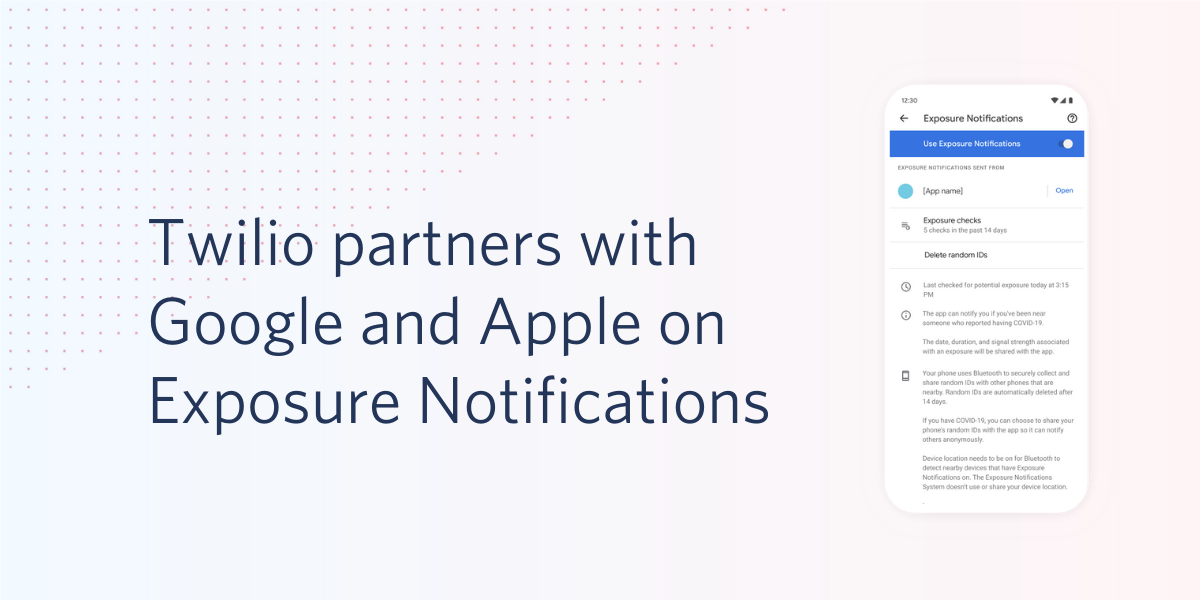Twilio partners with Google and Apple to stop COVID-19 with Exposure Notifications
Time to read: 4 minutes

One year into the COVID-19 pandemic, there’s light at the end of the tunnel, with multiple vaccines getting approved in countries around the world. At the same time, global infection rates are near all time highs due to winter seasonality, emerging virus variants, lockdown fatigue, and challenges in public compliance with public health guidelines.
While there’s good reason for optimism as vaccine distribution accelerates, inoculating 7 billion people will take time. That’s why it’s still essential that we take all available precautionary measures now and in the months to come. It’s also why Twilio is partnering with Google and Apple to power SMS messaging for Exposure Notifications.
Contact tracing that protects your privacy
Exposure Notifications is an open source API framework for contact tracing. The software uses Bluetooth to anonymously track human proximity and notify people if they are exposed to COVID-19.
Here’s how it works. Using short strings of randomly generated numbers, users’ phones send out beacons via Bluetooth to nearby devices, which can log contact proximity using these random strings as identifiers. If a participant in Exposure Notifications tests positive for COVID-19, the user can log this test result, and all people who have come in contact with that person receive notifications. All of this happens without exposing any users’ identities.
Twilio’s participation in Exposure Notifications builds on our experience working with public agencies to power contact tracing programs. Over the past year, we’ve partnered with health authorities to build cloud-scale contact centers using Twilio Flex that enable agents to communicate with residents safely and efficiently using voice, SMS, and email. Today, Twilio powers contact tracing programs covering nearly half the U.S. population, as well as many other cities, states, and countries globally.
Rapid notifications on your preferred channel
Through our work on contract tracing, we’ve seen firsthand the importance of using digital communications to rapidly alert someone when they’ve been exposed to COVID-19. Receiving a timely notification enables someone to take precautions and prevent exposing more people to the virus. However, not every contact tracing program is equipped to alert people programmatically - or via popular messaging channels - limiting the speed at which contact tracers can take action to slow the spread of the virus and help communities avoid unnecessary exposures.
In traditional contact tracing programs, call center agents conduct interviews over the phone, log instances of exposure, and then call people who may have been exposed to the virus to provide guidance on how to take appropriate safety precautions, such as self quarantining.
When public health authorities began to adopt the Exposure Notifications framework for their contact tracing programs in 2020, they ran into challenges when agents wanted to reach affected individuals quickly and at scale. When someone tests positive, a contact tracing agent provides the person with a unique code that they can enter into the Exposure Notifications app to indicate their positive test result. This input triggers the notifications to other people, and without this unique code no one can receive these critical alerts.
Of course, providing the code over the phone on a one-by-one basis doesn’t scale. When several thousand people in a given jurisdiction test positive in a single day, agents are unable to reach everyone on a timely basis. Public health authorities needed a solution to share these unique codes programmatically. Health authorities also wanted to provide codes in a way that allowed residents to easily take action. That’s where Twilio comes in.
A scalable solution for SMS notifications
Using the Programmable Messaging API, developers at Google and Apple built an integration that allows public health authorities to text users deep links for the Exposure Notifications app, with a unique code embedded in the link. By simply clicking on the link, the user is taken into the Exposure Notification app to initiate the anonymous notification process to alert the people they have come into contact with. For user privacy, Message Redaction ensures Twilio will not retain the message body or last four digits of the user’s phone number.
Best of all, these text messages are triggered programmatically, enabling contact tracers to reach thousands of individuals in just a few seconds. This efficiency allows agents to prioritize their time according to the specific needs of their programs. For example, agents could follow up with vulnerable populations who face greater risk from exposure, or focus their attention on inbound questions from people who have received an exposure alert. Ultimately, the result is that more people can get the help they need, right when they need it.
Join us in stopping the spread
We’re excited about the potential for Exposure Notifications to empower more health authorities to build contact tracing programs. Together, we can stop the spread. If you’re working on a contact tracing program or if you’re seeking to build one, we’d love to talk with you.
You can also learn more about the Exposure Notifications framework below:
If you reside in one of the jurisdictions currently served by the Exposure Notifications program, we encourage you to enroll today. If you’re an iPhone user, you can enable Exposure Notifications in your device settings. If you’re an Android user, you can download the Exposure Notifications app from the Google Play store (if available in your area).
Susan Lucas Collins is the Global Head of Healthcare Services at Twilio. She has extensive experience managing through shifting regulatory and reimbursement models, has provided trusted counsel to executives seeking insight in rapidly evolving markets, and is passionate about developing solutions that create a measurable difference in the world. Prior to Twilio, she led Salesforce’s healthcare and life sciences organization.
Justin Herman is Global Head of Public Sector for Twilio, ensuring the omnichannel communications fueling the most innovative companies is now available for our most critical public services. He currently serves as a member of the World Economic Forum and the U.S. Department of Labor-led Partnership on Employment & Accessible Technology (PEAT) Think Tank, as well as Industry Chair of the ACT-IAC IoT/Smart Cities Working Group.
Tony Fernandez is a seasoned Solution Architect where he works with Twilio’s largest customers to build innovative customer engagement solutions that can scale globally.
Related Posts
Related Resources
Twilio Docs
From APIs to SDKs to sample apps
API reference documentation, SDKs, helper libraries, quickstarts, and tutorials for your language and platform.
Resource Center
The latest ebooks, industry reports, and webinars
Learn from customer engagement experts to improve your own communication.
Ahoy
Twilio's developer community hub
Best practices, code samples, and inspiration to build communications and digital engagement experiences.


